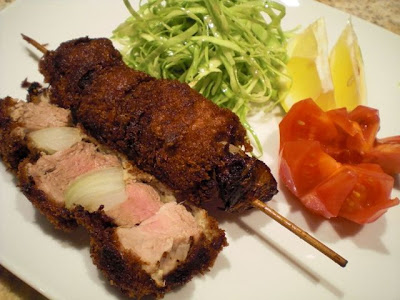This is again is a dish with which to finish your home Izakaya feast. This is a very simple soba noodle dish. We had this when I made "age-dashi tofu". This was a perfect dish to make since I wanted to finish the broth I made for the tofu dish. I simply dilute it further to the strength appropriate for this soba dish. Soba そば 蕎麦 is very popular even here in the U.S. and it is easy to get high-quality dried noodles. Of course you can make the noodles yourself. We have a soba cook book which describes how to make soba from buckwheat flour. I tried it once but, it is too difficult to make for an amateur like me and the dried variety is just fine.
There are two major ways to serve Soba; cold soba with a dipping sauce or "mori soba" もりそば and warm soba in broth or "kake soba" かけそば. There are many variations of both types of soba preparation depending on the condiments or toppings. For example, if you add tempura (usually shrimp), it is "tempura soba", if you add an egg it is "Tsukimi soba" 月見そば meaning moon-gazing soba since the egg yolk looks like a full moon. If you add seasoned fried tofu pouch (abura-age), then it is called "fox" soba きつねそば. You may ask why this is called "fox" soba. "Inari" shrine 稲荷神社, one of the many Japanese shrines, considers the white fox as a messenger of the deity or god it enshrines. Later, probably through misunderstanding, people started believing that the fox was the deity itself. It is also believed that the fox deity loves "abura-age" or deep fried tofu pouch. Thus, any dish which includes "abura-age" has "kitusne (fox)" or "inari" somewhere in it's name. Another common soba topping is "tenkasu" 天かす or small bits of cooked tempura batter that you scoop up while you are making tempura (this can be stored frozen for later use), then, it is called "tanuki" soba たぬきそば. There is a play on words here. "Tanuki" is a Japanese badger or more like a raccoon which is always compared to "kitsune" or fox since both animals are believed to use "magic" (mostly transmogrification) to mislead humans in Japanese folklore. It is said that "kitsune" is always very cunning and successful in her magic but "tanuki" is always comical and failing in his magic. For the name of the noodle dish, "ta-nuki" also means just temprura batter without other ingredients of tempura - "ta" means "other" and "nuki" means "missing" or "without".
We occasionally go to a small but elegant Japanese restaurant called "Makoto" in Washington DC, where they serves an excellent course menu おまかせ in the "kaiseki" style 懐石 or 会席. After 7-8 small exquisite dishes, the last dish they offer is soba in warm broth. There are some choices of toppings and we always go for "sansai" 山菜 or mountain vegetables. The soba dish I made here is a simplified version of this. I just put sliced fresh shiitake mushrooms in the broth and cooked it for a few minutes. I poured the hot broth over cooked soba noodles in a bowl and finished with chopped scallion and nori. If you like, sprinkle on the Japanese 7 flavored red pepper "sichimi tougarashi" 七味唐辛子.








